
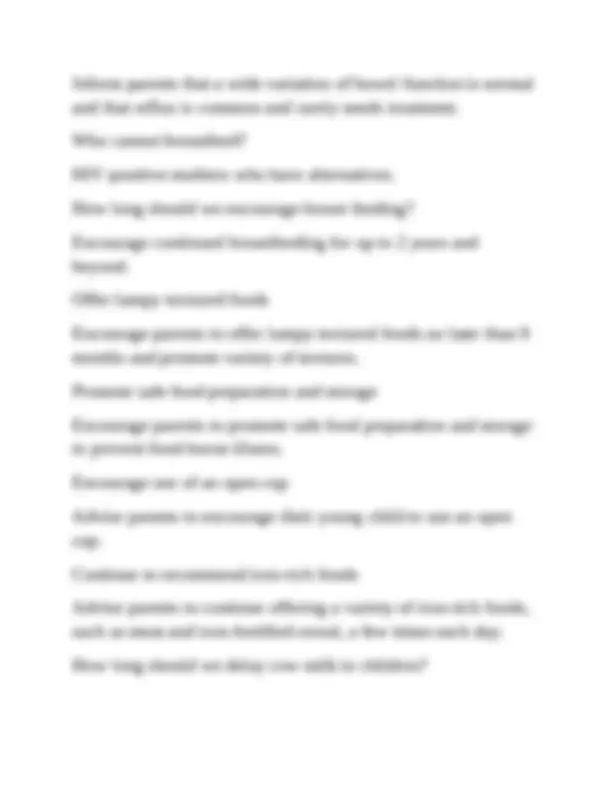
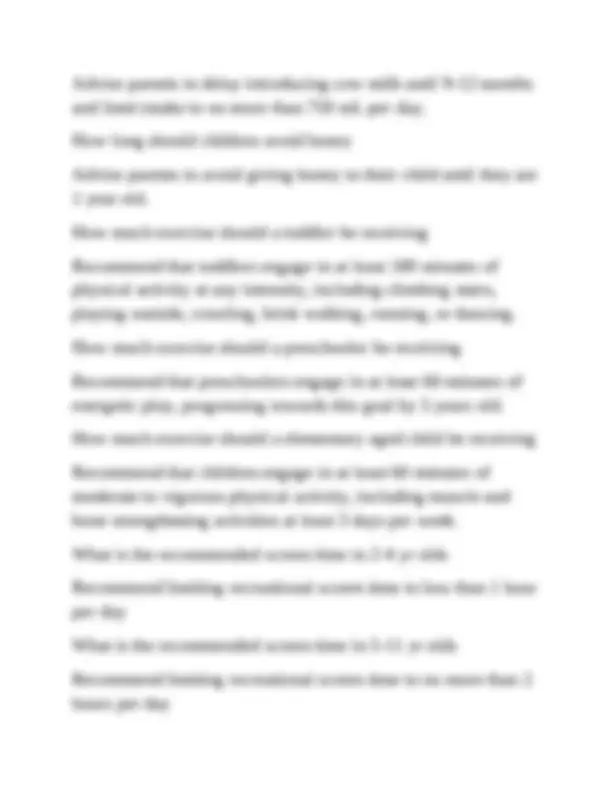
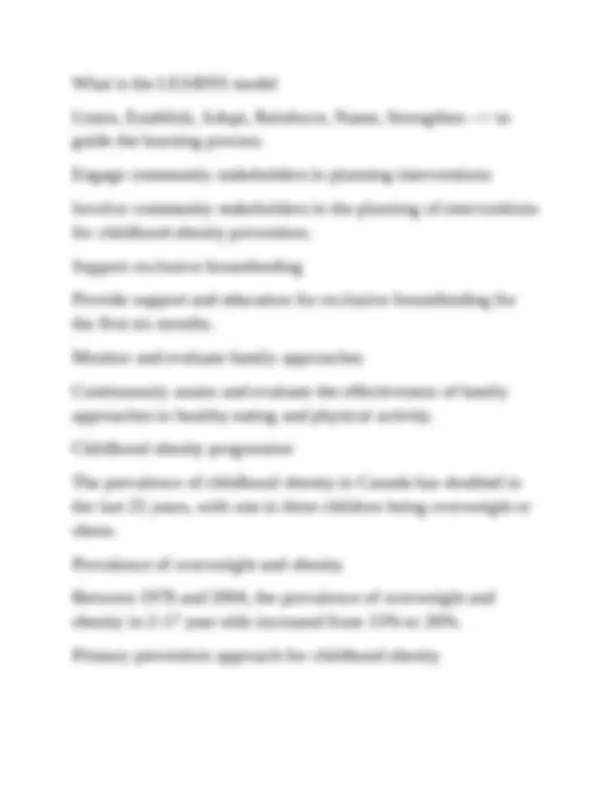
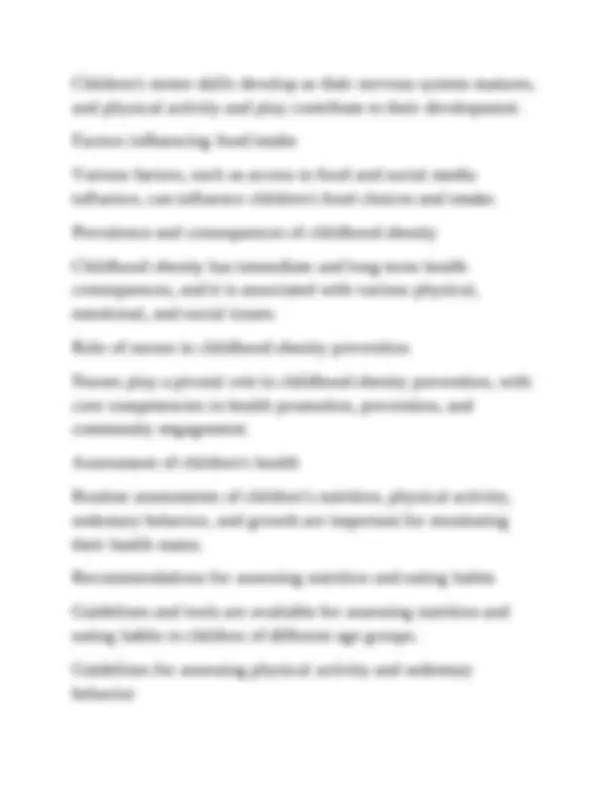
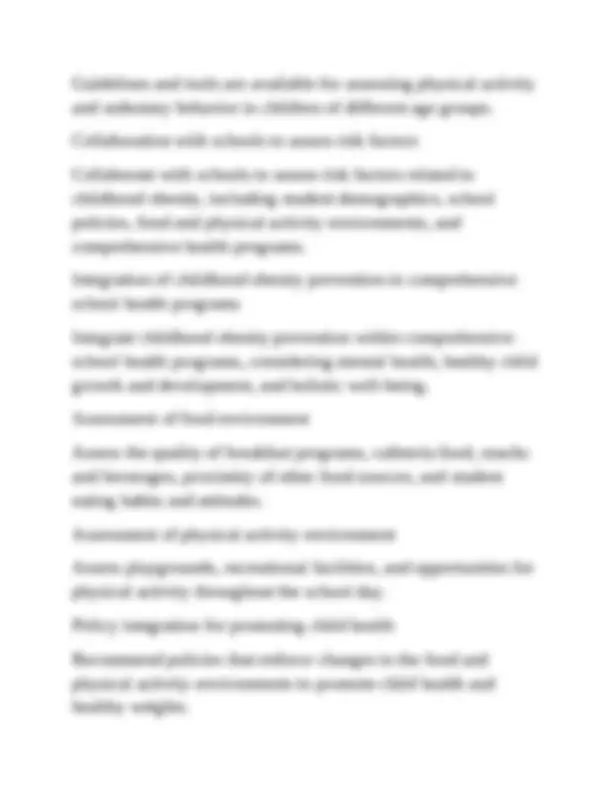
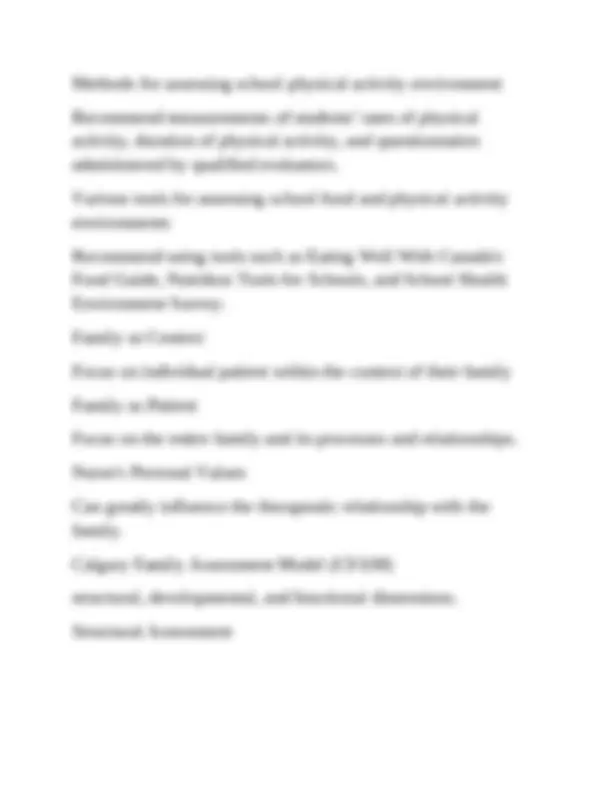
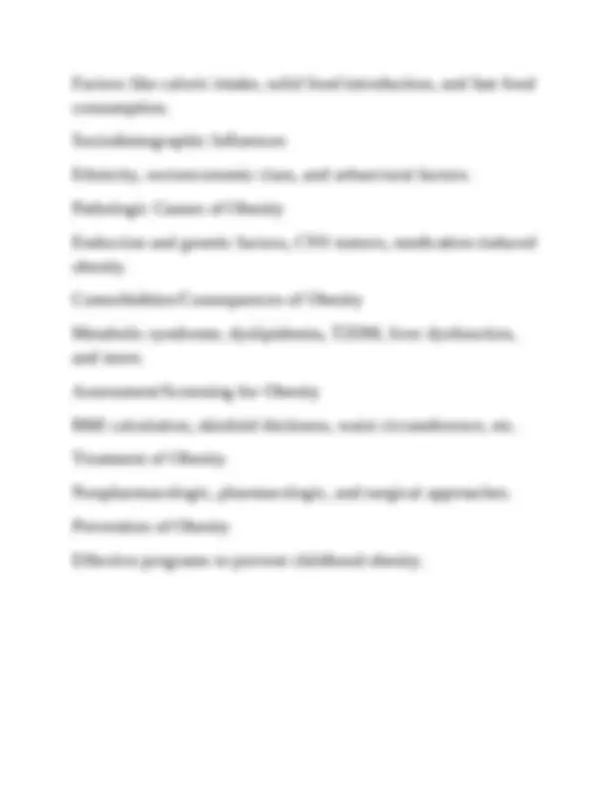


Study with the several resources on Docsity

Earn points by helping other students or get them with a premium plan


Prepare for your exams
Study with the several resources on Docsity

Earn points to download
Earn points by helping other students or get them with a premium plan
Community
Ask the community for help and clear up your study doubts
Discover the best universities in your country according to Docsity users
Free resources
Download our free guides on studying techniques, anxiety management strategies, and thesis advice from Docsity tutors
A comprehensive overview of childhood obesity prevention strategies for nurses. It covers various aspects, including assessment tools, interventions, and the role of nurses in promoting healthy eating and physical activity habits in children. The document emphasizes the importance of early and comprehensive assessments, collaboration with stakeholders, and a holistic approach to childhood obesity prevention.
Typology: Exams
1 / 13

This page cannot be seen from the preview
Don't miss anything!








Parent-Child Interaction Feeding and Teaching scales Assessment tool for all ages, measures parent-child interaction related to feeding and teaching. NutriSTEP Assessment tool for 18-35 months and 3-5 years, asks questions about food, food choices, eating habits, physical activity, and growth patterns. 5-2-1-0 framework Assessment tool for 2-8 years and 9-18 years, asks questions about consumption of fruits and vegetables, screen time, physical activity, consumption of sugar-sweetened drinks and milk, and includes a section for BMI. Physical activity questionnaire for children Assessment tool for 8-14 years, asks questions about general levels of fitness, physical activity, physical well-being, and motor skills development. Promoting Optimal Monitoring of Child Growth in Canada: Using the New WHO Growth Charts
Assessment tool for growth and development, uses WHO growth charts. Nipissing District Developmental Screen (NDDS) Assessment tool for emotional, fine motor, gross motor, social, self-help, communication, learning, and thinking skills. Parenting Stress Index Assessment tool to identify parenting characteristics that influence development and functioning. Personal environment assessments Assessment tool to assess the family's home environment and identify challenges and supportive resources. Family assessment instrument Assessment tool to assess a child's risk for healthy growth and development from birth to transition to school. Recommend daily vitamin D supplement Advise mothers to give their breastfeeding infants a daily vitamin D supplement of 400 IU. Use WHO growth charts Recommend using WHO growth charts for monitoring infants' growth. Reassure about bowel function
Advise parents to delay introducing cow milk until 9-12 months and limit intake to no more than 750 mL per day. How long should children avoid honey Advise parents to avoid giving honey to their child until they are 1 year old. How much exercise should a toddler be receiving Recommend that toddlers engage in at least 180 minutes of physical activity at any intensity, including climbing stairs, playing outside, crawling, brisk walking, running, or dancing. How much exercise should a preschooler be receiving Recommend that preschoolers engage in at least 60 minutes of energetic play, progressing towards this goal by 5 years old. How much exercise should a elementary aged child be receiving Recommend that children engage in at least 60 minutes of moderate to vigorous physical activity, including muscle and bone strengthening activities at least 3 days per week. What is the recommended screen time in 2-4 yr olds Recommend limiting recreational screen time to less than 1 hour per day What is the recommended screen time in 5-11 yr olds Recommend limiting recreational screen time to no more than 2 hours per day
What is the LEARNS model Listen, Establish, Adopt, Reinforce, Name, Strengthen --> to guide the learning process. Engage community stakeholders in planning interventions Involve community stakeholders in the planning of interventions for childhood obesity prevention. Support exclusive breastfeeding Provide support and education for exclusive breastfeeding for the first six months. Monitor and evaluate family approaches Continuously assess and evaluate the effectiveness of family approaches to healthy eating and physical activity. Childhood obesity progression The prevalence of childhood obesity in Canada has doubled in the last 25 years, with one in three children being overweight or obese. Prevalence of overweight and obesity Between 1978 and 2004, the prevalence of overweight and obesity in 2-17 year-olds increased from 15% to 26%. Primary prevention approach for childhood obesity
Early and comprehensive assessments Emphasize the importance of early and comprehensive assessments, collaboration with stakeholders, and a holistic approach to childhood obesity prevention. Genetic and environmental factors in childhood growth A child's growth is influenced by genetic inheritance, nutrition, and physical-socio cultural environments. Changes in respiratory and cardiovascular systems with age Respiratory and cardiovascular systems develop and change with age, affecting breathing rate, heart rate, and blood pressure. Growth and development differences between boys and girls Boys and girls have different growth and development patterns, including differences in height, weight, and maturation rates. Oral development and dental care Children's oral development includes the growth of teeth, which require proper dental care and maintenance. Lymph tissue development Lymph tissue grows rapidly in children, reaching maximal size before puberty and decreasing back to normal size afterwards. Motor skills development
Children's motor skills develop as their nervous system matures, and physical activity and play contribute to their development. Factors influencing food intake Various factors, such as access to food and social media influence, can influence children's food choices and intake. Prevalence and consequences of childhood obesity Childhood obesity has immediate and long-term health consequences, and it is associated with various physical, emotional, and social issues. Role of nurses in childhood obesity prevention Nurses play a pivotal role in childhood obesity prevention, with core competencies in health promotion, prevention, and community engagement. Assessment of children's health Routine assessments of children's nutrition, physical activity, sedentary behavior, and growth are important for monitoring their health status. Recommendations for assessing nutrition and eating habits Guidelines and tools are available for assessing nutrition and eating habits in children of different age groups. Guidelines for assessing physical activity and sedentary behavior
Methods for assessing school physical activity environment Recommend measurements of students' rates of physical activity, duration of physical activity, and questionnaires administered by qualified evaluators. Various tools for assessing school food and physical activity environments Recommend using tools such as Eating Well With Canada's Food Guide, Nutrition Tools for Schools, and School Health Environment Survey. Family as Context Focus on individual patient within the context of their family Family as Patient Focus on the entire family and its processes and relationships. Nurse's Personal Values Can greatly influence the therapeutic relationship with the family. Calgary Family Assessment Model (CFAM) structural, developmental, and functional dimensions. Structural Assessment
Internal and external structure of the family. eg Genograms and ecomaps Internal Structure Composition, gender, sexual orientation, rank order, subsystems, boundaries. External Structure Extended family, larger systems, ethnicity, race, social class, religion, environment. Developmental Assessment Examines family growth and stages of development. Expanded Family Life Cycle emerging young adults forming couples families with young children adolescents midlife transitions late middle age end of life stages. Functional Assessment examines family members' interactions and behavior, with a focus on instrumental and expressive functioning.
Factors like caloric intake, solid food introduction, and fast food consumption. Sociodemographic Influences Ethnicity, socioeconomic class, and urban/rural factors. Pathologic Causes of Obesity Endocrine and genetic factors, CNS tumors, medication-induced obesity. Comorbidities/Consequences of Obesity Metabolic syndrome, dyslipidemia, T2DM, liver dysfunction, and more. Assessment/Screening for Obesity BMI calculation, skinfold thickness, waist circumference, etc. Treatment of Obesity Nonpharmacologic, pharmacologic, and surgical approaches. Prevention of Obesity Effective programs to prevent childhood obesity.